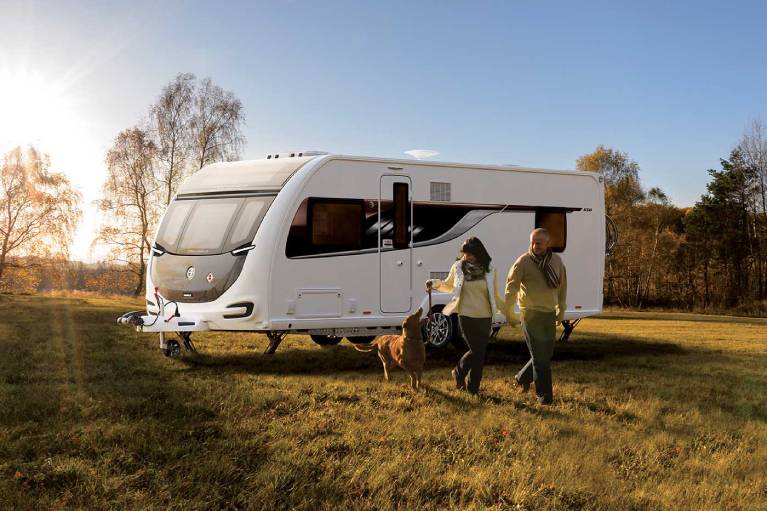Raindrops To Sunshine: Weatherproofing Your Caravan & Awning For Every Season
Caravanning can be great fun – except when you’re cold and wet, having an awful time in the British weather. Nothing is worse than sleeping and eating in a damp, draughty caravan with mould growing in all the nooks and crannies.
That’s why weatherproofing is essential. It lets you take your caravan and awning into nature year-round.
But what is weatherproofing? And how do you protect your caravan against the rain, wind, snow, and sun?
That’s what this post will teach you. We explore each of these aspects of weatherproofing one by one. By the end, you should have all the knowledge you need to have fun no matter what the weather does.

Rain
In the UK, rain is fairly well distributed throughout the year. Late winter to spring is the driest period, with October to January the wettest.
As a caravanner, rain is probably your biggest bugbear. It can damage the walls and awning if it gets into the interiors.
Here’s a list of tasks that will help you keep the rain out for longer:-
- Check your caravan’s chassis regularly for cracks or scuffs that might allow water to enter
- Fix any gaps around the roof, windows, or doors with specialist sealants or tapes
- Use a waterproof tarpaulin to cover your caravan while not in use
- Choose a water-resistant awning material for the awning
- Apply water-repellent spray or coating to the awning fabric to enhance its water-resistance
- Ensure the awning is well-pegged and tensioned according to the manufacturer’s specifications to prevent pooling on the roof
Wind
According to the Met Office, winter is the UK’s windiest time. The jet steam tracks further south, allowing more Atlantic storms to blow over the country.
Unfortunately, wind can cause your caravan and awning to flap uncontrollably or blow away. Many poor souls have watched helplessly as their equipment flutters into the distance, carried by the wind.
Again, though, you can protect your caravan and awning against the wind. Here’s a list of what to do:-
- Anchor and stabilise your caravan and awning securely during windy weather
- Use a combination of sturdy poles, pegs, and guy ropes to keep everything in place. (Check the manufacturer’s specifications for tolerated wind speeds. Consider upgrading your equipment if travelling to windier parts of the country on the west coast).
- Check your caravan’s brakes, handbrake and tyres for wear and tear
- Use a wheel clamp or lock to stop your vehicle from rolling away in stormy weather
Snow
Snow is another risk in the UK. It can add extra weight to your caravan and awning, causing crush damage.
Snow is most likely to occur in England in December and January. However, it can occur as early as November and as late as March in rare cases.
As you probably already know, snow is cold and heavy, so it’s essential to ensure your caravan and awnings are strong and well-insulated against it.
Here is your snow-proofing checklist:
- If there’s snow on your awning or caravan roof, remove it gently with a brush. Don’t let it build up.
- Choose an awning material, such as vinyl or PVC, that is strong and can resist tearing, even if there is a lot of weight on it
- Use a heater inside your caravan to prevent damaging frost from forming
- Prevent condensation from freezing with a dehumidifier
Dealing with cold weather can be challenging and energy-intensive. Therefore, ensure you have extra fuel and battery power for snow-related challenges in the winter.
Sun
Lastly, you may need to deal with the sun since it can also damage your caravan. Sun damage is greatest around the summer solstice when the sun reaches its maximum height in the sky, and insolation is most intense.
Unfortunately, the sun can cause cracking and material damage. UV light may harm your caravan’s paintwork or cause organic molecules in your awning to break down, weakening it. It can even damage items inside the vehicle.
Fortunately, there’s still plenty you can do. Here’s how you can protect your caravan from the sun and hot weather:-
- Use curtains and tinted windows to prevent bright sunlight inside
- Choose UV-resistant awning materials
- Add a fan or air conditioner to your caravan to keep the interior cool, comfortable and safe
If you’re interested in financing a new or used caravan, get a quote from us today. Auto Finance Online makes getting the RV or camper of your dreams easier, offering competitive rates and the ability to borrow up to £100,000.
Get a Quote
payments of
Cash price £15,000, deposit £0, total amount of credit £15,000, term 7 years, 84 monthly payments of £244.99, on a hire purchase agreement, option to purchase fee £1, total amount payable £20,578.77, representative APR 9.9%, rate of interest 9.9% fixed.
Rates may differ as they are dependent on individual circumstances. Subject to status.

